Table of Contents[Hide][Show]

Great northern beans are a lesser-known variety of white bean. They are sometimes called “large white beans”, which is a bit of a misnomer, as they are in fact larger than navy beans, but smaller than cannellini beans. They have a slightly flat shape similar to lima beans, and a delicate flavor. Beans are a part of the legume family, which has both amazing history and nutrient benefits!
Legumes might not be the most fancy, flashy, or exciting foods out there, but don’t let their humble looks deceive you: this food group is a health-boosting powerhouse! And did you know this food family has a secret power – they can actually make music?! You know…”beans, beans, the musical fruit…”
Legumes are the fruit or seed of plants from the Fabaceae (also called Leguminosae) family, which includes members such as beans, lentils, peas, and peanuts. And while technically, the food family includes immature versions of some beans such as edamame and edible podded peas, those green versions are often lumped with vegetables. Therefore, legumes are generally regarded as pulses—the starchy, dried seeds of legume plants.
Legumes were an important staple food for numerous ancient cultures, and every major civilization has included a legume as part of their food system. Over time, legumes became the centerpiece of a number of iconic national dishes through the Middle East, India, Brazil, Greece, Egypt and many more!
Legumes have been, and are to this day, an important staple food for every major civilization in history!
Along with having a long shelf life and extreme versatility, legumes are a very sneaky way to enhancing the nutrient density of meals as they are among the most nutrient-dense starchy plant foods available. They’re rich in phytonutrients, bioactive peptides, essential micronutrients including a large list of minerals, and resistant starch (a form of fiber)—all of which contribute to their wide-ranging health effects.
Great northern beans can be found readily throughout North America in both dried and canned forms. They were originally cultivated in South America but now have a global presence among many cultures who use legumes and beans as a dietary staple! These white beans are botanically classified as Phaseolus vulgaris alongside other popular beans such as: red kidney, pinto, black, navy, and pink.
They were originally cultivated in South America but are widely used across many cultures all over the world!
These lesser known white beans are often confused or substituted with cannellini beans, because of their similarities. While cannellini beans have thicker skin and a stronger taste they are often used in soups, stews and chili-type dishes, however the great northern bean is more delicate and lends itself better to stand alone uses such as side dishes or in a meal such as a shrimp and white beans, or beans and rice recipes from Southern and Cajun cooking styles.
Let’s see if these beans can live up to their “great” name!
Learn What Foods to *ADD* to Your Diet
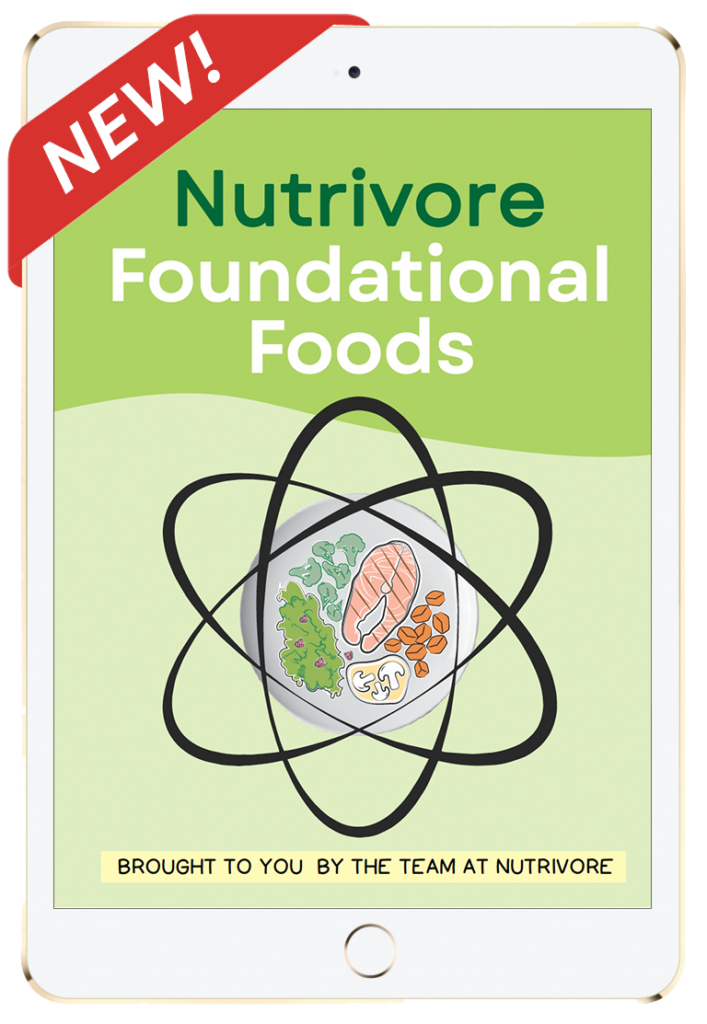
Nutrivore Foundational Foods
Learn what makes the 12 Nutrivore foundational food families nutritionally unique, their health benefits, which options are the most nutrient dense, how much of them to eat, plus various fun facts, practical pointers, and busting of common myths.
This very helpful resource will introduce you to new foods and expand your nutrition knowledge, making food choices easier!
Buy now for instant digital access.
Nutrivore Score for Great Northern Beans – 419
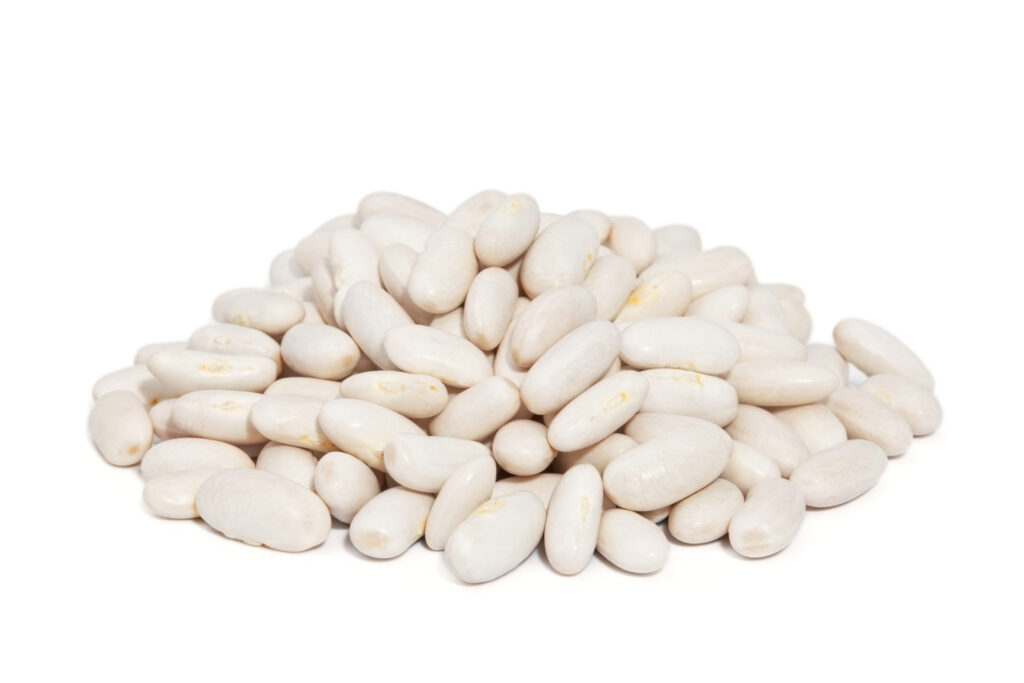
Great northern beans have a Nutrivore Score of 419, making them a high nutrient-dense food! Plus, they are a low-fat food; great northern beans contain 0.3 grams total fat per serving!
Per serving, great northern beans are a best source (>50% daily value) of polyphenols; an excellent source (20-50% daily value) of copper, dietary fiber, and vitamin B9 (folate); and a good source (10-20% daily value) of magnesium, manganese, phosphorus, protein, and vitamin B1 (thiamin).
Ditch Diets. Embrace Nutrients. Start with this FREE Guide.
Sign up for the free Nutrivore Newsletter, your weekly, science-backed guide to improving health through nutrient-rich foods — without dieting harder —and get the Beginner’s Guide to Nutrivore delivered straight to your inbox!

Great Northern Bean Nutrition Facts
One serving of great northern beans is standardized to 1/6 cup raw or about 31 grams (1.1 ounces). When you cook great northern beans, they increase in volume: 1 cup raw great northern beans is roughly equivalent to 3 cups cooked great northern beans.
Great Northern Bean Nutrition Facts Per Serving
| Great northern beans, raw | Nutrivore Score: 419 | Nutrient Density: High |
|---|---|---|
| Serving Size: 1/6 cup raw or 1/2 cup cooked | Protein: 6.7 grams | Net Carbohydrates: 12.9 grams |
| Calories: 103 | Total Fat: 0.3 grams | Dietary Fiber: 6.2 grams |
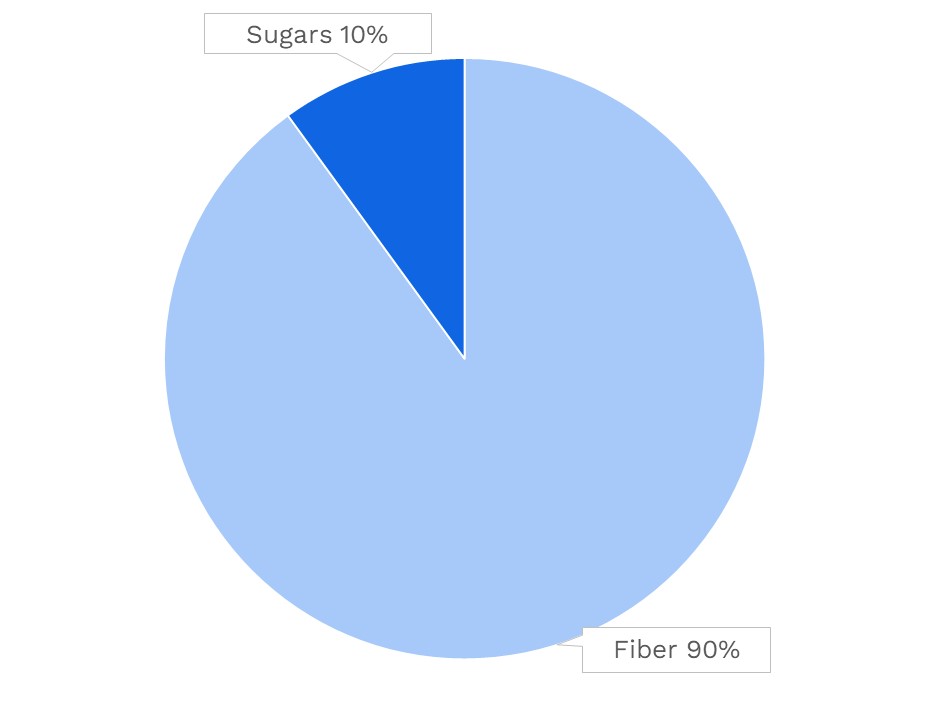

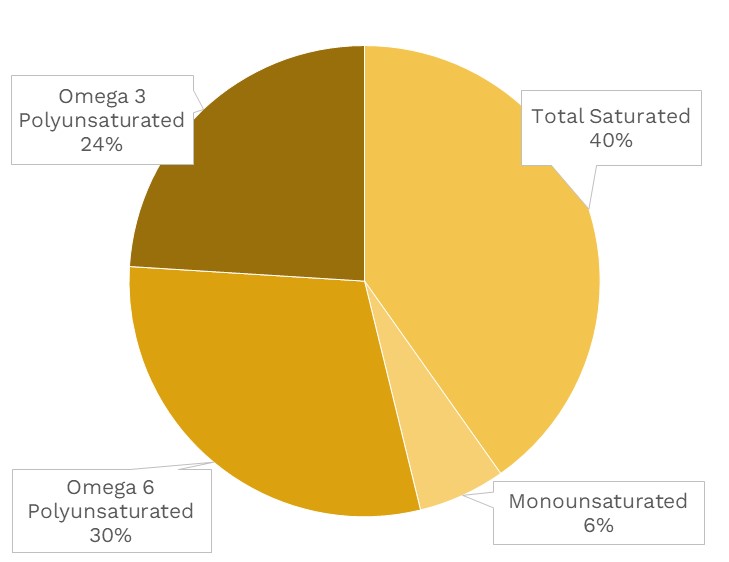
| VITAMINS | ||
|---|---|---|
| Vitamin A | 0.0 μg RAE | 0% DV |
| Vitamin B1 (Thiamin) | 199.2 μg | 17% DV |
| Vitamin B2 (Riboflavin) | 72.3 μg | 6% DV |
| Vitamin B3 (Niacin) | 0.6 mg | 4% DV |
| Vitamin B5 (Pantothenic Acid) | 0.3 mg | 7% DV |
| Vitamin B6 (Pyridoxine) | 136.3 μg | 8% DV |
| Vitamin B7 (Biotin) | ~ | ~ |
| Vitamin B9 (Folate) | 147.0 μg | 37% DV |
| Vitamin B12 (Cobalamin) | 0.0 μg | 0% DV |
| Vitamin C | 1.6 mg | 2% DV |
| Vitamin D (D2 + D3) | 0.0 μg | 0% DV |
| Vitamin E | 0.1 mg | 0% DV |
| Vitamin K | 1.8 μg | 2% DV |
| Choline | 26.8 mg | 5% DV |
| Myo-Inositol | 99.7 mg | ~ |
| CoQ10 | ~ | ~ |
| FUNCTIONAL FATS | ||
|---|---|---|
| MUFA | 0.0 g | 0% DV |
| ALA | 65.0 mg | 4% DV |
| EPA + DHA | 0.0 mg | 0% DV |
| CLA | ~ | ~ |
| Linoleic Acid | 0.1 g | 0% DV |
| MCT’s | 0.0 g | ~ |
| MINERALS | ||
|---|---|---|
| Calcium | 53.4 mg | 4% DV |
| Copper | 255.3 μg | 28% DV |
| Iodine | ~ | ~ |
| Iron | 1.7 mg | 9% DV |
| Magnesium | 57.6 mg | 14% DV |
| Manganese | 434.0 μg | 19% DV |
| Phosphorus | 136.3 mg | 11% DV |
| Potassium | 423.0 mg | 9% DV |
| Selenium | 3.9 μg | 7% DV |
| Sodium | 4.3 mg | 0% DV |
| Zinc | 0.7 mg | 6% DV |
| PHYTONUTRIENTS | ||
|---|---|---|
| Carotenoids | 0.0 μg | ~ |
| Polyphenols | 1538.9 mg | ~ |
| Phytosterols | ~ | ~ |
| Glucosinolates | ~ | ~ |
| Thiosulfinates | ~ | ~ |
| Betalains | ~ | ~ |
| AMINO ACIDS & PEPTIDES | ||
|---|---|---|
| Taurine | ~ | ~ |
| Ergothioneine | ~ | ~ |
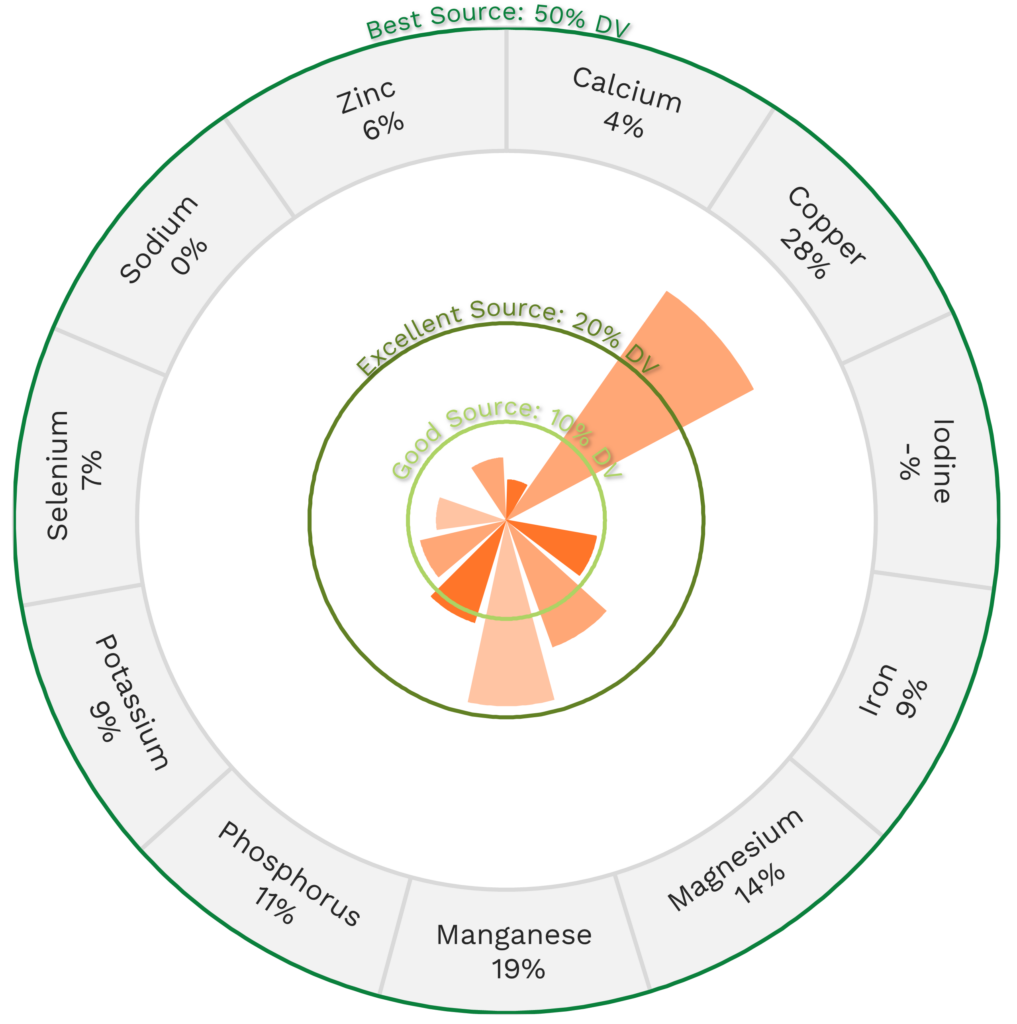
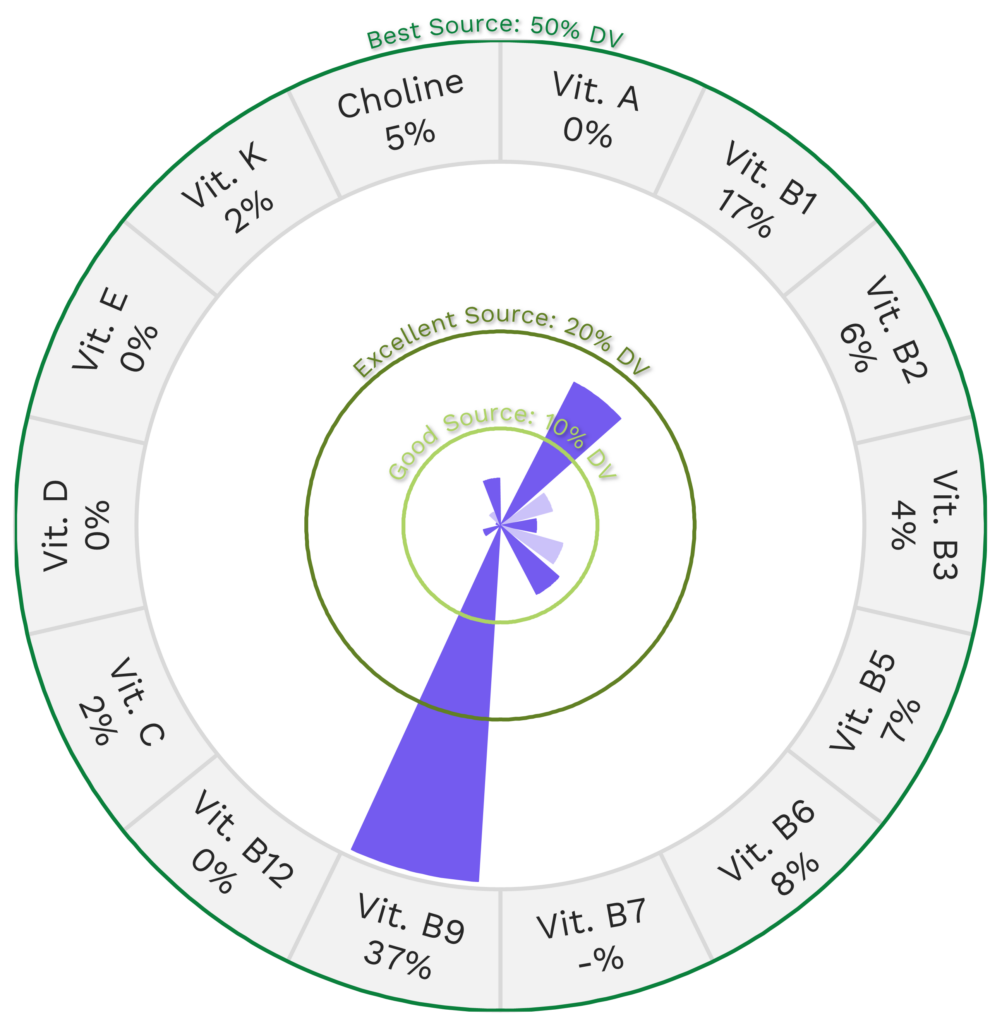
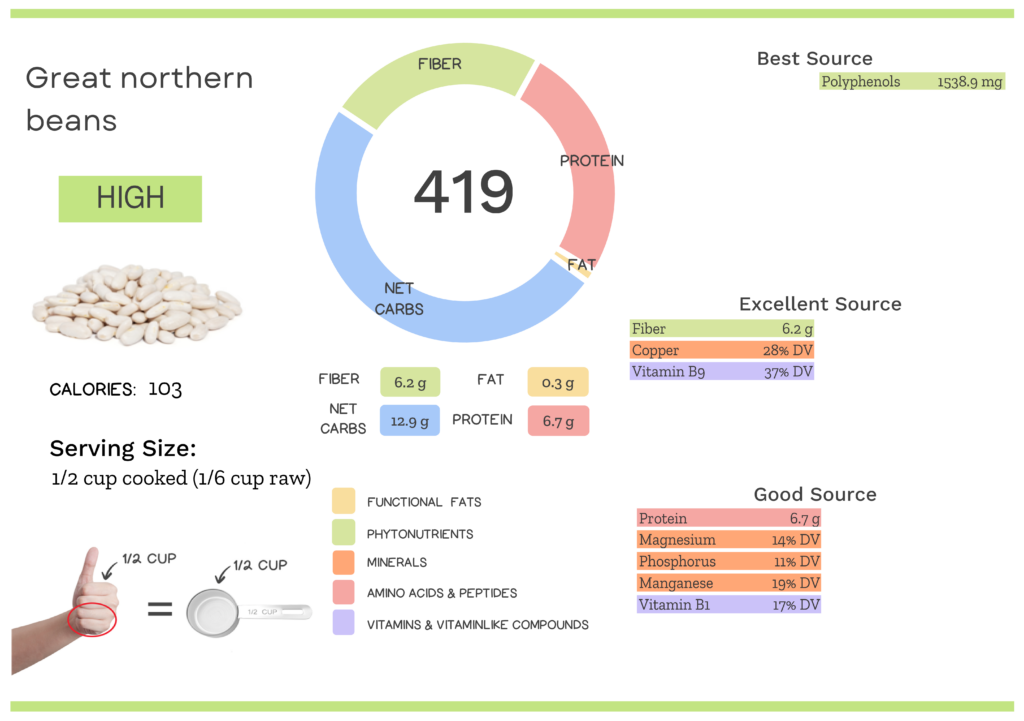
Great Northern Bean Nutrition Varies With Cooking and Processing
The Nutrivore Score of great northern beans varies based on method of preparation and processing. Conveniently, canned great northern beans are available at most grocery stores.
| NUTRIVORE SCORE | |
|---|---|
| Great northern beans, mature seeds, canned | 364 |
| Great northern beans,, mature seeds, cooked, boiled, with salt | 389 |
| Great northern beans, mature seeds, cooked, boiled, without salt | 389 |
| Great northern beans, mature seeds, raw | 419 |
Bean Nutrition Varies With Type
There are numerous kinds of beans, ranging in color, flavor, shape, size, texture, and nutrient profile, which means their Nutrivore Scores vary as well. Choose the ones you like best but try incorporating different varieties in your diet to maximize all the nutrition that beans have to offer.
| NUTRIVORE SCORE | |
|---|---|
| Adzuki beans, mature seeds, raw | 5761 |
| Black beans, mature seeds, raw | 446 |
| Cowpeas, common (blackeyes, crowder, southern), mature seeds, raw | 238 |
| Chickpeas (Garbanzo beans), mature seeds, raw | 454 |
| Cranberry (Roman) beans, mature seeds, raw | 2651 |
| Fava beans (Broad beans), mature seeds, raw | 442 |
| Great Northern beans, mature seeds, raw | 419 |
| Kidney beans, red, mature seeds, raw | 413 |
| Lima beans, large, mature seeds, raw | 304 |
| Mung beans, mature seeds, raw | 249 |
| Navy beans, mature seeds, raw | 269 |
| Pinto beans, mature seeds, raw | 390 |
| Soybeans, mature seeds, raw | 326 |
| White beans, mature seeds, raw | 2221 |
Have you “bean” impressed with all of the nutrition in great northern beans? Maybe your friends will be too!
Health Benefits of Great Northern Bean Nutrients
Let’s take a closer look at all of the best and excellent source of nutrients found in a 1/6-cup serving of great northern beans and see how they benefit our health.
Great Northern Beans Provide 1538.9 mg of Polyphenols
Great northern beans are a best source of polyphenols, providing 1538.9 mg of polyphenols per 1/6-cup serving!
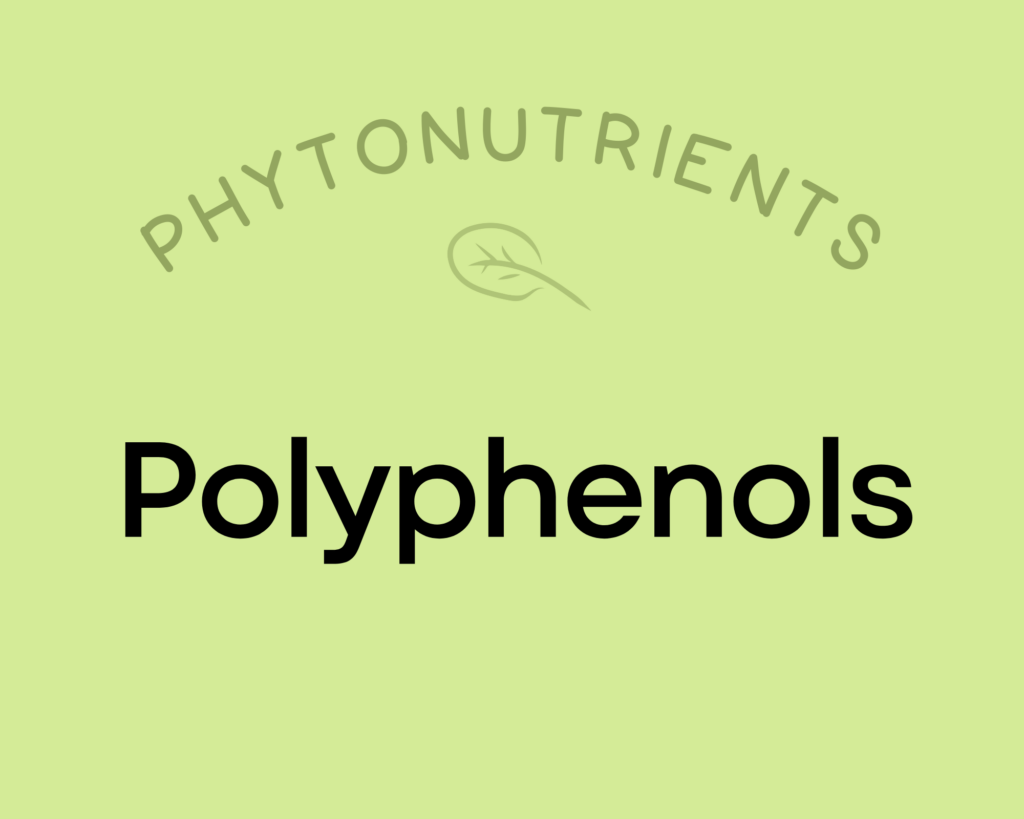
Polyphenols play a huge role in protecting against cancer, heart disease, diabetes, asthma, osteoporosis, neurodegenerative diseases, and other conditions associated with oxidative stress. In fact, a major reason foods like red wine and olive oil (as well as diets rich in both, such as the Mediterranean diet) show up as so beneficial may be due to their high polyphenol content! Along with chronic diseases, supplementing with polyphenols has been shown to protect against infections and reduce the signs of aging. Polyphenols exert their most potent effects by acting as antioxidants—preventing cellular damage by neutralizing hazardous oxygen radicals and improving cellular health as a result (which, in turn, benefits virtually every system in the body). As a result of their antioxidant properties, polyphenols also boost the immune system and protect against both chronic and acute diseases. In addition, polyphenols can help regulate enzyme function, stimulate cell receptors, modulate the functions of inflammatory cells (including T and B lymphocytes, macrophages, platelets, and natural killer cells), alter adhesion molecule expression, affect nerve cells and cardiac muscle cells, and exert antiviral effects. Learn more about polyphenols here.
Great Northern Beans Provide 37% DV Vitamin B9 (Folate)
Great northern beans are an excellent source of vitamin B9 (folate), providing 37% of the daily value per 1/6-cup serving!

Vitamin B9 (folate) is an essential B vitamin that plays roles in blood cell production, the formation of genetic material (including DNA), and cell growth and function. It’s particularly important during pregnancy, when folate demands increase due to the rapid creation of new cells and DNA. Along with helping protect against fetal development problems, folate can support cardiovascular health, potentially protect against certain cancers, and reduce the risk of cognitive and neurological disorders later in life. Learn more about vitamin B9 here.
Great Northern Beans Provide 28% DV Copper
Great northern beans are also an excellent source of copper, providing 28% of the daily value per 1/6-cup serving!
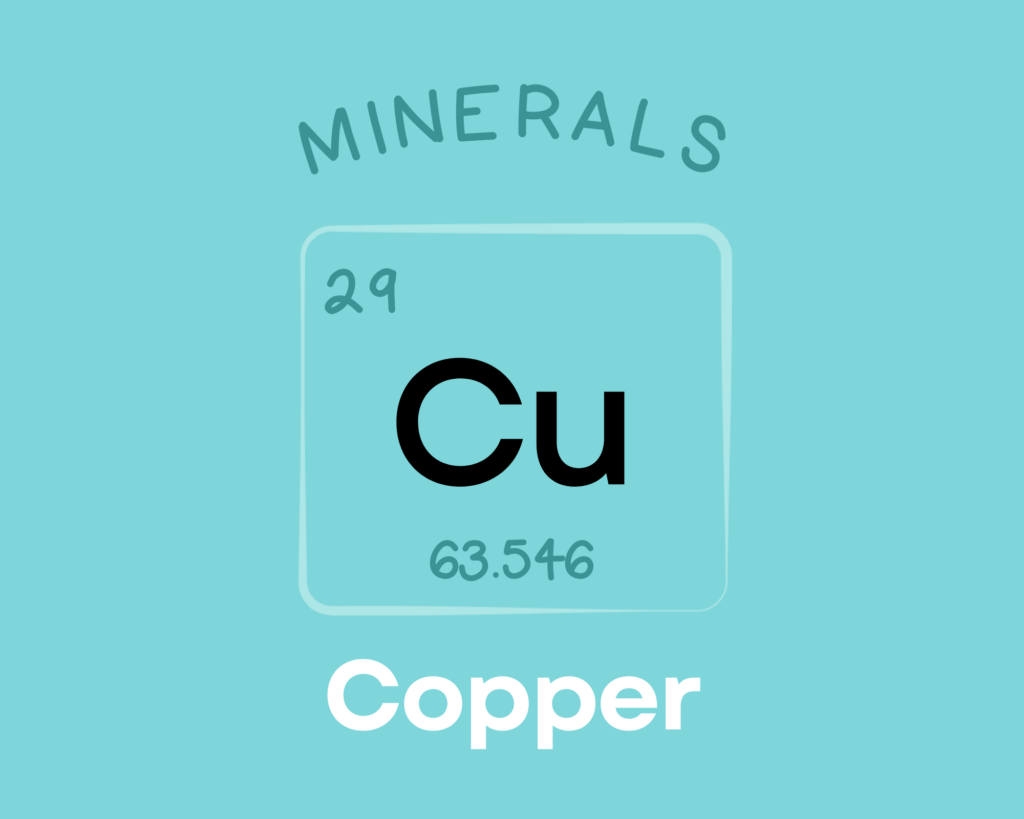
Copper is a trace mineral that’s essential for all living organisms. Copper serves as a component of numerous enzymes and proteins in the body, giving it diverse roles in the growth, development, and maintenance of various organs (including the heart and brain), bone, and connective tissue. Copper is also involved in glucose and cholesterol metabolism, helps regulate gene expression, can scavenge free radicals, and is needed for the production of red blood cells. Learn more about copper here.
Great Northern Beans Provide 6.2 g of Fiber
Great northern beans are an excellent source of dietary fiber, providing 6.2 g of fiber per 1/6-cup serving!
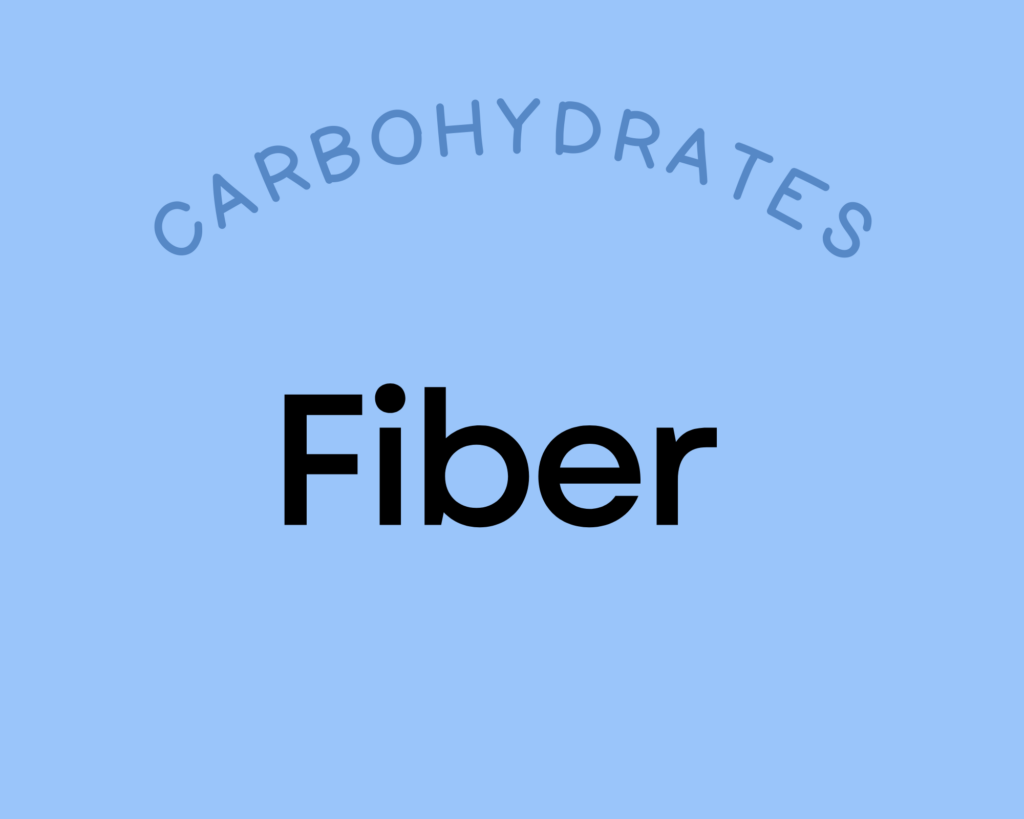
Fiber serves as substrate for the trillions of microbes that inhabit our digestive tracts, collectively referred to as the gut microbiome. Through their metabolism of fiber, these resident microbes benefit us in a whole host of ways, including aiding digestion, vitamin production, detoxification, regulation of cholesterol metabolism, providing resistance to pathogens, immune regulation, neurotransmitter regulation, regulation of gene expression, and more! In fact, every human cell is impacted by the activities of our gut microbes. A healthy gut microbial community is essential for our health. And, the converse is also true: An aberrant gut microbiome has been linked to conditions as wide-ranging as cancer, obesity, diabetes, cardiovascular disease, anxiety, depression, neurodegenerative diseases, autism, autoimmune disease, ulcers, IBD, liver disease, gout, PCOS, osteoporosis, systemic infections, allergies, asthma, and more!
Fiber has other benefits, like regulating peristalsis of the intestines (the rhythmic motion of muscles around the intestines that pushes food through the digestive tract), stimulating the release of the suppression of the hunger hormone ghrelin (so we feel more full), and slowing the absorption of simple sugars into the bloodstream to regulate blood sugar levels and avoid the excess production of insulin. Fiber also binds to various substances in the digestive tract (like hormones, bile salts, cholesterol, and toxins) and, depending on the type of fiber, can facilitate either elimination or reabsorption (for the purpose of recycling, which is an important normal function for many substances like bile salts and cholesterol), both of which can be extremely beneficial—if not essential—for human health.
The recommended dietary intake for fiber is 14 grams per 1000 kcal, which translates to 28 grams of fiber, if you eat a 2,000 calorie per day diet. However, there are many studies showing greater benefits from even higher levels of intake. Lear more about fiber here.
Want to know the top 500 most nutrient-dense foods?
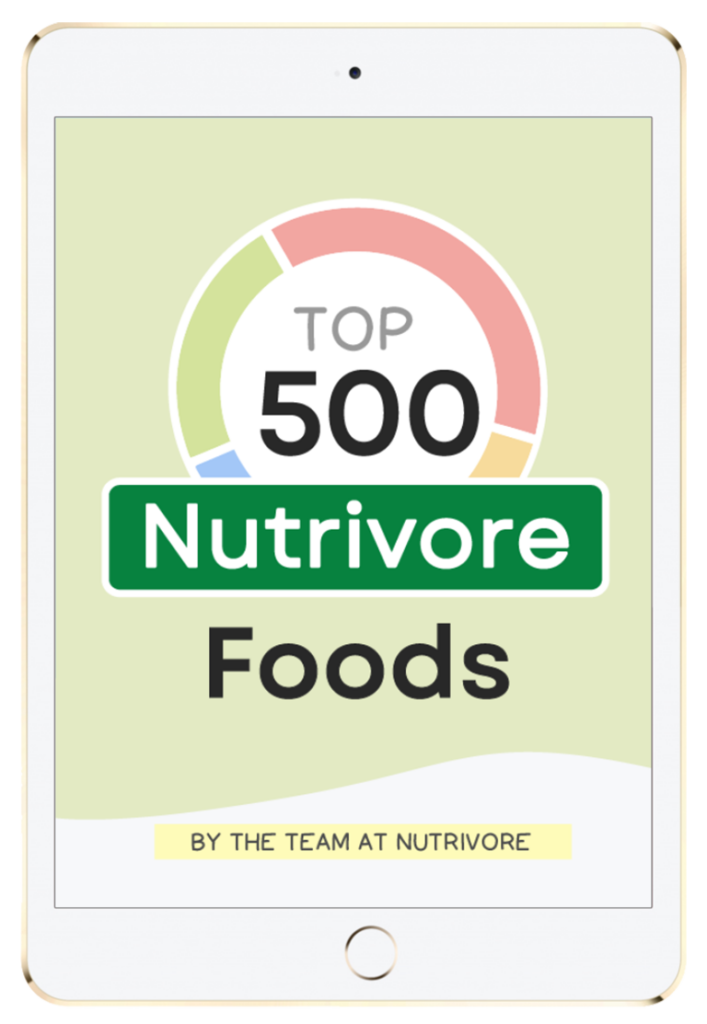
Top 500 Nutrivore Foods
The Top 500 Nutrivore Foods e-book is an amazing reference deck of the top 500 most nutrient-dense foods according to their Nutrivore Score. Think of it as the go-to resource for a super-nerd, to learn more and better understand which foods stand out, and why!
If you are looking for a quick-reference guide to help enhance your diet with nutrients, and dive into the details of your favorite foods, this book is your one-stop-shop!
Buy now for instant digital access.
How Much Great Northern Beans Should We Eat Per Day?
On average, legumes are the most nutrient-dense starchy plant foods we can choose to eat, thanks to their high fiber content and phytonutrients, all of which result in diverse health benefits!
In epidemiological studies, consumption of legumes is frequently associated with better health and greater longevity. This is attributable to their amazing nutrient-density (especially fiber, vitamins and minerals) and the fact that they’re particularly great for increasing growth of probiotic bacteria in our guts. Across studies, beans have demonstrated a great number of health benefits, likely due to their combination of fiber and phytonutrients. A high consumption of beans is associated with reduced waist size, lower risk of obesity, and lower systolic blood pressure.
A large 2017 meta-analysis showed that all-cause mortality (a general indicator of health and longevity) decreased by 16% with increasing intake of legumes up to 150 grams (3 servings) per day. And, in a 2021 study, eating 3+ servings of legumes per week reduces all-cause mortality by 17% compared to 2 servings per month. Learn more about legumes here.
Easily track your servings of Nutrivore Foundational Foods!

The Nutrivore Weekly Serving Matrix
The Nutrivore Weekly Serving Matrix digital resource is an easy-to-use and flexible weekly checklist designed to help you maximize nutrient-density and meet serving suggestions of Nutrivore foundational foods, all without having to weigh or measure your foods!
Includes a 22-page instructional guide and downloadable interactive guides.
Buy now for instant digital access.
cITATIONS
Expand to see all scientific references for this article.
Clements RS Jr, Darnell B. Myo-inositol content of common foods: development of a high-myo-inositol diet. Am J Clin Nutr. 1980 Sep;33(9):1954-67. doi: 10.1093/ajcn/33.9.1954. PMID: 7416064.
USDA Food Central Database: Beans, great northern, mature seeds, canned
USDA Food Central Database: Beans, great northern, mature seeds, raw (includes foods for USDA’s Food Distribution Program)
Yang QQ, Gan RY, Ge YY, Zhang D, Corke H. Polyphenols in Common Beans (Phaseolus vulgaris L.): Chemistry, Analysis, and Factors Affecting Composition. Compr Rev Food Sci Food Saf. 2018 Nov;17(6):1518-1539. doi: 10.1111/1541-4337.12391. Epub 2018 Oct 11. PMID: 33350144.


